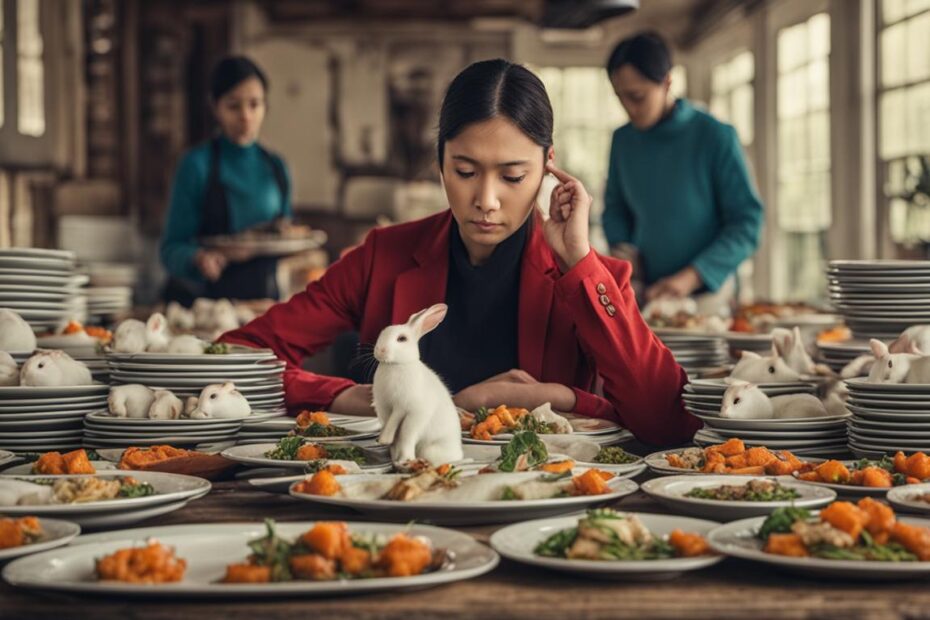Are you curious about the nutritional benefits of rabbit meat and the safe consumption levels? You’ve come to the right place. In this article, we’ll explore the factors to consider when it comes to eating rabbit meat and how much is safe for consumption.
Key Takeaways:
- Eating too much rabbit meat without enough fat and/or carbohydrates can lead to protein poisoning or rabbit starvation.
- It is important to diversify your diet and consume fats from other sources to avoid protein poisoning.
- Rabbit meat is a lean protein source, low in fat, and rich in essential vitamins and minerals.
- Rabbit meat can be a heart-healthy option when consumed in moderation.
- Proper handling and cooking techniques are crucial for the safe consumption of rabbit meat.
How Much Rabbit Can You Eat
Here’s a summary of domestic rabbit meat prices in the United States:
- Retail Prices (November 2023):
- Wholesale Prices (2023):
- Export and Import Trends:
- The export price per kilogram of rabbit meat from the US has seen fluctuations over the years. In 2022, it was around $1.75 per kilogram, and it is likely to remain similar in 2023 and 20241.
- The import price per kilogram of rabbit meat into the US has been relatively stable, ranging between $1.42 and $2.88 over the last five years. Predictions indicate an import price of around $2.00 in 2023 and $1.60 in 20241.
- Export Values:
Remember that these prices can vary based on location, market demand, and other factors. If you’re interested in buying or selling rabbit meat, I recommend checking the latest prices and offers available from reliable sources. 🐇
The Origins of Rabbit Starvation
Rabbit starvation, also known as protein poisoning or mal de caribou, has its roots in the wild frontier days when people faced starvation during harsh winter months. This condition occurs when one consumes excessive protein without enough fat and/or carbohydrates, leading to malnourishment despite a full stomach. Contrary to its name, rabbit meat is not the exclusive cause of rabbit starvation; it can also occur with other lean meats. However, due to the common consumption of rabbit meat during these times, it became associated with the condition.
Indigenous people who had a better understanding of local vegetation and habitats did not suffer from rabbit starvation as frequently as frontiersmen. This was because they knew how to diversify their diet to include essential fats and carbohydrates from various sources. The lack of sufficient fats and carbohydrates, rather than rabbit meat itself, is the primary contributing factor to the development of rabbit starvation.how much rabbit meat cost
“Rabbit starvation occurs when one consumes excessive protein without enough fat and/or carbohydrates, leading to malnourishment despite a full stomach.”
During the wild frontier days, rabbit meat was commonly consumed due to its availability and ease of hunting. However, these historical accounts remind us of the importance of maintaining a balanced diet even when facing challenging survival situations. Today, actual cases of rabbit starvation are rare, and the condition is often mistaken for other common survival-related problems.
| Causes of Rabbit Starvation | Contributing Factors |
|---|---|
| Excessive consumption of lean protein | Lack of sufficient fats and carbohydrates in the diet |
| Reliance on rabbit meat as the primary protein source | Insufficient knowledge of diverse food sources |
| Long-term survival situations in harsh environments | Limited access to other sources of fat and carbohydrates |
Symptoms and Diagnosis of Rabbit Starvation
Rabbit starvation, also known as protein poisoning, can have several symptoms that indicate a lack of essential nutrients in the diet. These symptoms include:
- Diarrhea: One of the most common symptoms reported by individuals experiencing protein poisoning.
- Nausea: The feeling of queasiness or an upset stomach.
- Fatigue: A state of extreme tiredness or exhaustion.
- Headaches: Pain or discomfort in the head or upper neck area.
- Ammonia in Blood: In severe cases, ammonia levels in the blood may increase, indicating a breakdown of protein for energy.
It is important to note that these symptoms can be similar to those experienced in other survival scenarios or medical conditions, making it challenging to accurately diagnose rabbit starvation. If you are experiencing digestive problems or any of the mentioned symptoms while consuming a diet high in rabbit meat or other lean proteins, it is essential to diversify your diet and ensure proper hydration.
In severe cases, diarrhea caused by protein poisoning can lead to dehydration, so it may be beneficial to keep anti-diarrheal medications in a first aid kit. Always consult a healthcare professional if you have concerns about your symptoms or overall health.
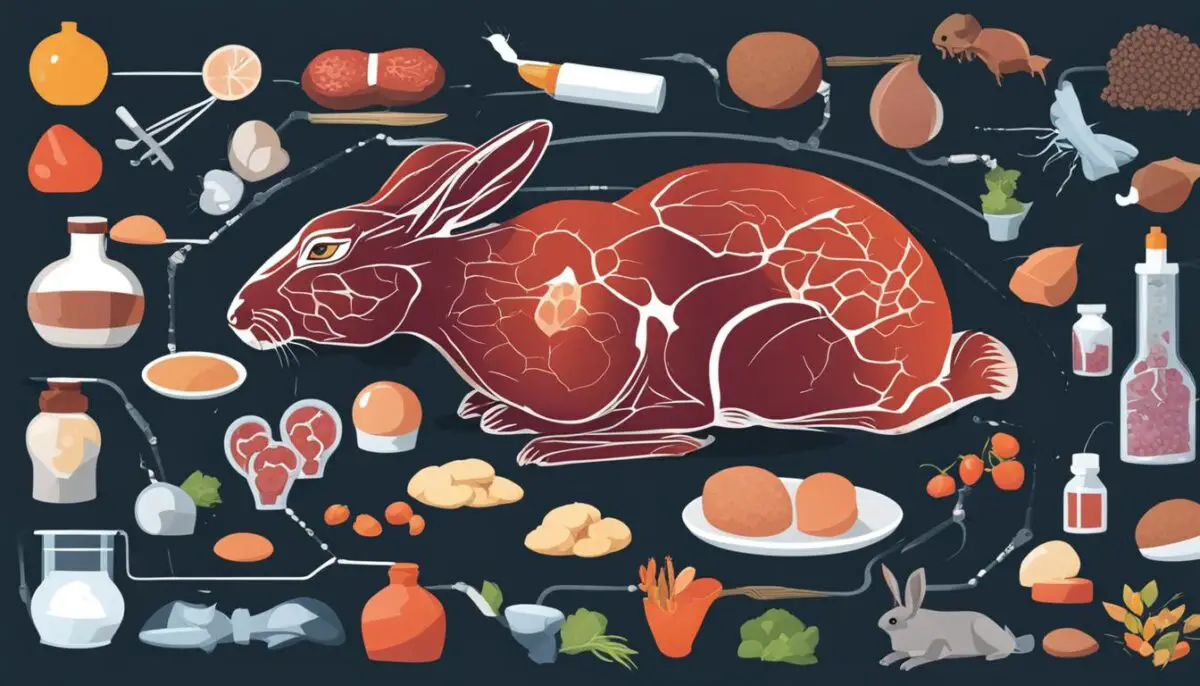
| Symptoms of Rabbit Starvation (Protein Poisoning) | Prevalence |
|---|---|
| Diarrhea | Common |
| Nausea | Common |
| Fatigue | Common |
| Headaches | Common |
| Ammonia in Blood | Rare (severe cases) |
Historical Cases of Rabbit Starvation
Throughout history, there have been documented cases of rabbit starvation, also known as protein poisoning, primarily occurring in survival situations or when individuals heavily rely on rabbit meat as their main source of sustenance. Let’s explore some notable cases:
1. Roman Soldiers
“During ancient times, Roman soldiers often faced dire conditions, including instances where they had to rely solely on rabbits for sustenance. Unfortunately, their consumption of lean rabbit meat without an adequate intake of fats and carbohydrates led to dysentery and malnutrition.”
2. Hudson Bay Company Trappers
“In the early days of the Hudson Bay Company trappers in Canada, rabbit starvation was a common occurrence. The trappers experienced severe malnourishment, as rabbit meat lacks essential vitamins and minerals necessary for survival.”
3. Charles Darwin
“During his travels aboard the HMS Beagle, Charles Darwin encountered mild cases of rabbit starvation. He observed that consuming lean meats like rabbits without a balanced diet could lead to nutritional deficiencies, causing adverse effects on overall health.”
4. Vilhjalmur Stefansson
Vilhjalmur Stefansson, an arctic explorer and anthropologist, conducted studies on rabbit starvation and experimented with an all-meat diet. He experienced protein poisoning but successfully recovered by reintroducing fats back into his diet.
5. Chris McCandless
Chris McCandless, portrayed in the book “Into the Wild,” is often associated with rabbit starvation, although the exact cause of his death is still debated. His story highlights the risks of relying solely on rabbit meat for survival without proper nutritional balance.
These historical cases of rabbit starvation serve as a reminder of the importance of a well-rounded diet and the potential risks of consuming excessive amounts of lean proteins without sufficient fats and carbohydrates. rabbit meat prices
Table: Historical Cases of Rabbit Starvation
| Case | Description |
|---|---|
| Roman Soldiers | Roman soldiers experienced dysentery and malnutrition due to relying solely on rabbit meat. |
| Hudson Bay Company Trappers | Trappers in Canada suffered from severe malnourishment as rabbit meat lacks essential vitamins and minerals. |
| Charles Darwin | During his travels, Darwin observed the adverse effects of consuming lean meats without a balanced diet. |
| Vilhjalmur Stefansson | The arctic explorer experienced and studied rabbit starvation, recovering by reintroducing fats into his diet. |
| Chris McCandless | The association between McCandless and rabbit starvation highlights the risks of an imbalanced diet. |
Rabbit Meat’s Popularity and Perception
Rabbit meat has experienced a decline in popularity over time, particularly in the United States. This may be attributed to the perception of rabbits as pets, which can make people uncomfortable with the idea of consuming them as food. However, it is important to recognize that rabbit meat is a sustainable and healthy source of protein.cost of rabbit meat per pound
When considering the sustainability of rabbit meat, it’s worth noting that rabbits have a high reproductive rate and require less land, feed, and water compared to traditional livestock. This makes rabbit farming more environmentally friendly and resource-efficient. Additionally, raising rabbits for meat can be done in a way that prioritizes their welfare, advocating for group housing instead of confining them to small cages.buying rabbit meat
Cultural opinions on eating rabbit vary across different countries and regions. In some cultures, rabbit meat is a common and accepted part of the culinary tradition. However, in other cultures, rabbits are considered companions or pets, leading to a cultural aversion to consuming them. These cultural attitudes and beliefs play a significant role in shaping the perception of rabbit meat as a food source.
Despite these considerations, it is important to recognize the nutritional value of rabbit meat as a protein source. It is low in fat, making it a heart-healthy option. Rabbit meat can be incorporated into a balanced diet, providing essential nutrients such as vitamin B-12 and selenium. Ultimately, the decision to consume rabbit meat is a personal choice influenced by cultural, ethical, and dietary factors.
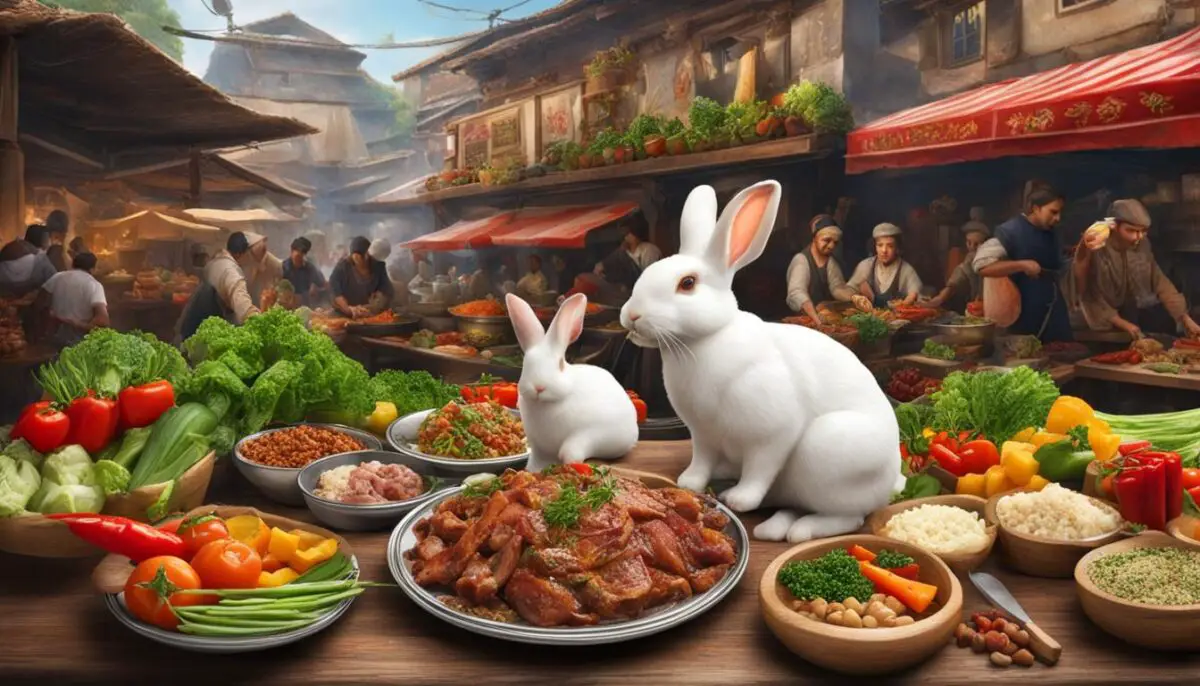
Table: A Comparison of Rabbit Meat and Other Protein Sources
| Protein Source | Protein Content per 100g | Fat Content per 100g | Calories per 100g |
|---|---|---|---|
| Rabbit Meat | 29.1g | 3.6g | 197 |
| Chicken Breast | 31g | 3.6g | 165 |
| Beef (Lean) | 26g | 5g | 250 |
| Pork Tenderloin | 20g | 3 | 143 |
Nutritional Benefits of Rabbit Meat
Rabbit meat is a nutritious option that offers numerous health benefits. It is a lean source of protein, making it an excellent choice for those looking to maintain or build muscle mass. Rabbit meat contains less fat compared to other meats like beef, which can contribute to a healthier diet. With a 100 gram serving of rabbit meat providing 29.1 grams of protein, incorporating rabbit meat into your meals can support your body’s muscle growth and repair processes.rabbit meat cost in America
In addition to being a source of lean protein, rabbit meat also offers several essential vitamins and minerals. It is rich in vitamin B-12, which is crucial for red blood cell production and maintaining a healthy nervous system. Rabbit meat is also a good source of selenium, which supports immune system function and helps regulate thyroid hormone production.
When considering the nutritional benefits of rabbit meat, it is important to note that it is relatively low in calories. A 100 gram serving of rabbit meat contains approximately 197 calories, making it a healthier alternative to fattier cuts of meat. Incorporating rabbit meat into your diet can help support your overall health and well-being.
| Nutrient | Amount per 100g |
|---|---|
| Protein | 29.1g |
| Calories | 197 |
| Vitamin B-12 | 2.1mcg |
| Selenium | 30.6mcg |
Incorporating rabbit meat into your diet can provide you with essential nutrients while being a flavorful addition to your meals. Whether you choose to roast, braise, sauté, or bake rabbit meat, it can be a versatile protein option that offers great taste and health benefits.
Availability and Sourcing of Rabbit Meat
If you’re interested in trying rabbit meat, you can find it in various places. Local butcher shops, farmers’ markets, and some grocery stores often carry rabbit meat. However, it may be more readily available in urban areas compared to rural areas. To ensure you’re purchasing high-quality rabbit meat, consider buying from reputable sources that prioritize the well-being of the animals.rabbit meat cost in America
If you prefer a more hands-on approach, you can also consider hunting rabbit. Hunting can be an exciting and rewarding way to source your own meat. Before embarking on a hunting trip, it’s important to familiarize yourself with local regulations, obtain the necessary permits, and ensure you have the appropriate hunting gear.
Once you have acquired rabbit meat, it’s essential to follow proper cleaning and storing procedures to maintain its freshness and prevent foodborne illnesses. When cleaning rabbit meat, thoroughly rinse it with cold water and pat it dry. It’s important to handle raw meat with care, keeping it separate from other foods to prevent cross-contamination. Store the meat in a sealed container in the refrigerator or freezer, depending on when you plan to use it.
| Where to Buy | Pros | Cons |
|---|---|---|
| Local Butcher Shops | – High-quality meat | – Limited availability in some areas |
| Farmers’ Markets | – Supports local farmers | – Seasonal availability |
| Grocery Stores | – Convenient and accessible | – Limited selection |
| Hunting | – Exciting and rewarding | – Requires permits and hunting gear |
Image source: seowriting.ai/32_6.png
Cooking Rabbit Meat
When it comes to cooking rabbit meat, there are several methods you can use to bring out its delicious flavors. Whether you prefer the tenderness of roasted rabbit or the rich flavors of braised meat, there’s a cooking technique that suits your taste. Here are some popular methods for cooking rabbit meat:rabbit meat market rates
Roasting
Roasting is a classic way to prepare rabbit meat, allowing it to cook slowly and evenly. To roast rabbit, preheat your oven to 350°F (175°C). Season the meat with herbs, spices, and olive oil, then place it on a roasting rack in a baking dish. Roast uncovered for about 20 minutes per pound, or until the internal temperature reaches 160°F (71°C). Let the meat rest for a few minutes before slicing and serving.
Braising
Braising is a great method for tenderizing rabbit meat and infusing it with flavor. Start by searing the rabbit in a hot pan with a little oil until it’s golden brown on all sides. Remove the meat and set it aside. In the same pan, sauté onions, garlic, carrots, and herbs until softened. Deglaze the pan with wine or broth, then return the rabbit to the pan. Cover and simmer on low heat for about 1.5 to 2 hours, or until the meat is tender and easily pulls apart with a fork.
Sautéing and Baking
If you’re short on time, sautéing or baking rabbit meat are quick and easy options. To sauté rabbit, heat oil in a skillet over medium-high heat. Cut the meat into smaller pieces, season with salt and pepper, then cook for about 3-4 minutes per side until golden brown and cooked through. For baking, coat the rabbit meat with breadcrumbs or a marinade of your choice, then place it in a baking dish. Bake at 375°F (190°C) for about 25-30 minutes, or until the internal temperature reaches 160°F (71°C).
| Cooking Method | Description |
|---|---|
| Roasting | Rabbit meat is cooked slowly in the oven, resulting in tender and flavorful results. |
| Braising | Rabbit meat is seared, then slow-cooked in a liquid, infusing it with rich flavors and tenderness. |
| Sautéing | Rabbit meat is quickly cooked in a skillet with oil, perfect for a fast and tasty meal. |
| Baking | Rabbit meat is coated with breadcrumbs or marinade and cooked in the oven for a simple and delicious dish. |
Storing Rabbit Meat
When it comes to storing rabbit meat, proper handling and storage practices are essential to maintain its freshness and quality. Whether you have leftover cooked rabbit meat or raw meat that you want to freeze for future use, following these guidelines will help ensure food safety and prevent any bacterial growth.
Storing Cooked Rabbit Meat:
After enjoying a delicious rabbit meal, it’s important to store any leftovers properly. Cooked rabbit meat can be refrigerated in an airtight container for up to three days. Make sure to cool it down to room temperature before storing it in the refrigerator. If you have a larger quantity of leftovers, you can divide them into smaller portions for easier storage and reheating.
Freezing Raw Rabbit Meat:
If you want to freeze raw rabbit meat, it’s crucial to handle it with care to prevent bacterial contamination. Before freezing, ensure the meat is fresh and has not been previously frozen. Wrap the rabbit meat tightly in plastic wrap or place it in a sealed freezer bag. It’s advisable to label the package with the date to keep track of its freshness. When freezing, maintain a temperature of 0°F (-18°C) or below to prevent the growth of harmful bacteria.affordable rabbit meat
When you’re ready to use the frozen rabbit meat, thaw it in the refrigerator over the course of a day or two. Avoid thawing at room temperature or using hot water, as this can create an environment for bacteria to multiply. Once thawed, cook the rabbit meat thoroughly before consuming.
Proper storage and handling practices are essential for enjoying rabbit meat safely. By following these guidelines, you can ensure the freshness and quality of your rabbit meat, whether it’s cooked leftovers or raw meat that you plan to freeze for future use.
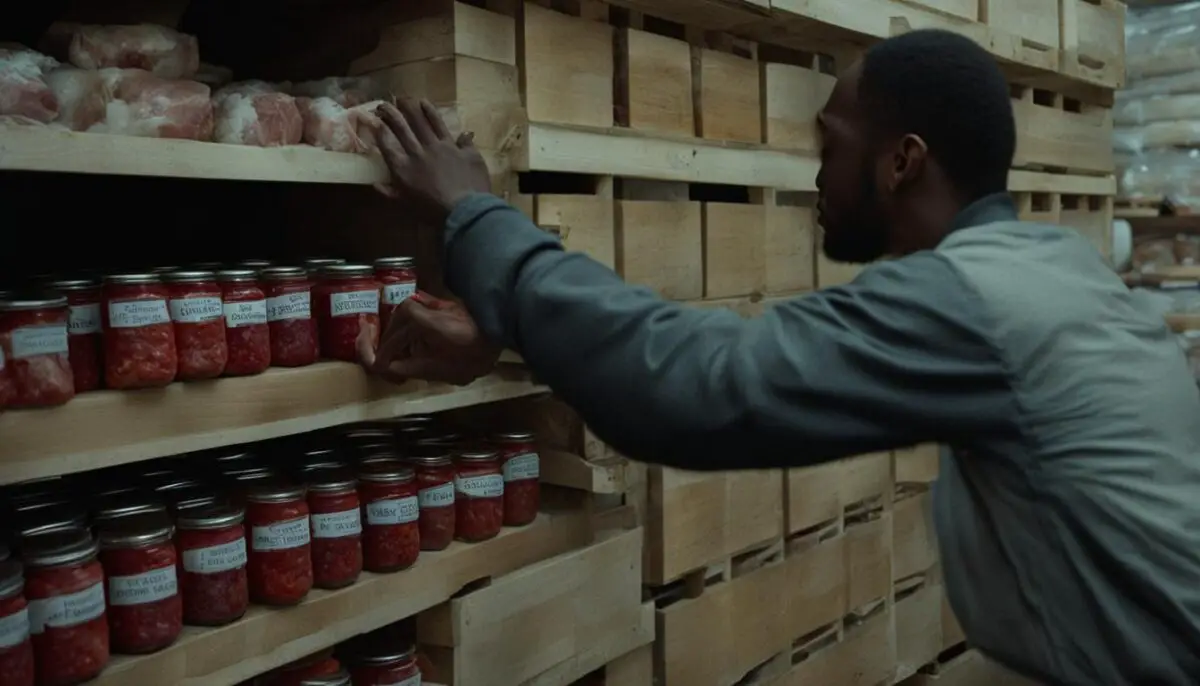
Enjoying Rabbit Meat Safely
When it comes to enjoying rabbit meat, it’s important to prioritize safety in handling and consumption. By following proper guidelines, you can ensure a safe and enjoyable dining experience.where to find cheap rabbit meat
Cleaning and Handling
Before cooking rabbit meat, it’s crucial to clean it thoroughly. Rinse the meat under cool, running water to remove any surface bacteria. Pat dry with paper towels to remove excess moisture. It’s essential to practice good hygiene by washing your hands and the utensils used in handling the meat to prevent cross-contamination.
“Clean the rabbit meat thoroughly under cool, running water to remove any surface bacteria.”
Additionally, proper storage is essential to maintain the quality and safety of the meat. Raw rabbit meat should be stored in the refrigerator at temperatures below 40°F (4°C). To extend its shelf life, you can also freeze rabbit meat in airtight containers or freezer bags. When defrosting frozen rabbit meat, do so in the refrigerator over a day or two to prevent bacterial growth.
Safe Consumption
When cooking rabbit meat, it’s crucial to ensure it reaches a safe internal temperature to eliminate any potential pathogens. Use a meat thermometer to check that the meat has reached an internal temperature of 160°F (71°C). This ensures that the meat is fully cooked and safe to eat.average price of rabbit meat
“Use a meat thermometer to check that the rabbit meat has reached an internal temperature of 160°F (71°C) for safe consumption.”
“Proper handling and cooking techniques are key to enjoying rabbit meat without the risk of foodborne illness.”
By practicing safe handling and consumption practices, you can enjoy the flavors and nutritional benefits of rabbit meat without compromising your health. Remember to clean the meat thoroughly, handle it with clean hands and utensils, and cook it to the recommended internal temperature for a safe and delicious meal.
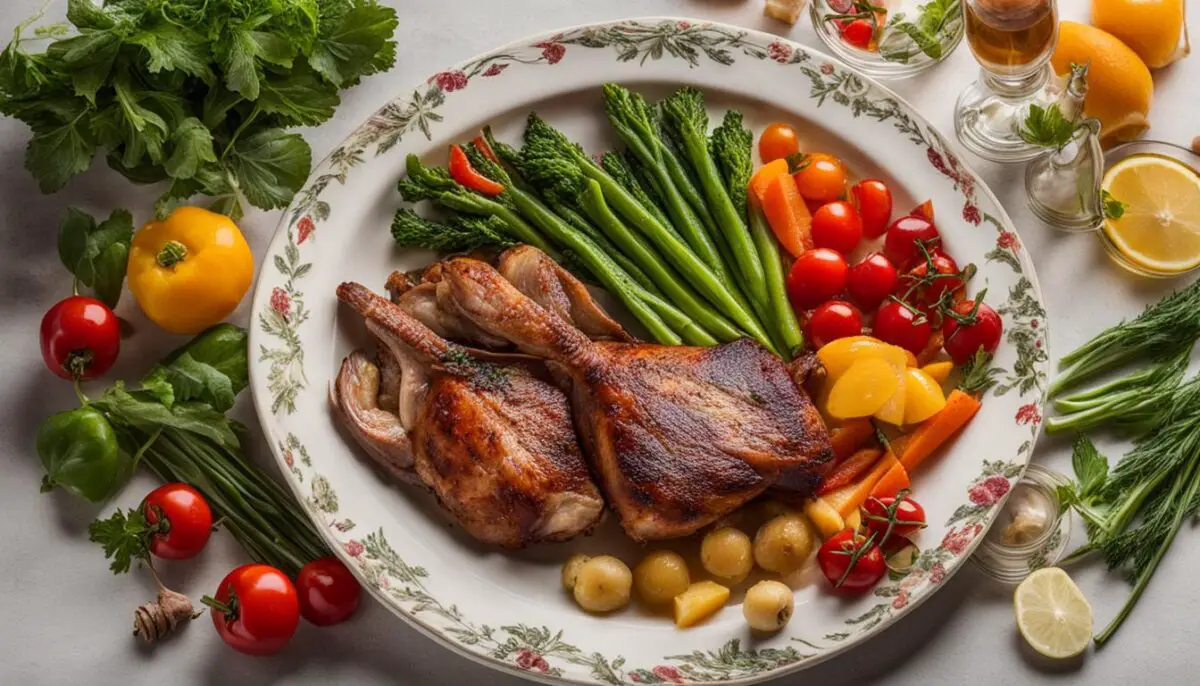
Rabbit Meat as a Heart-Healthy Option
Rabbit meat is not only a delicious and versatile protein source, but it also offers numerous health benefits, making it a heart-healthy option for those looking to maintain a balanced diet. With its lean protein content and low-fat profile, rabbit meat provides a nutritious alternative to fattier meats like beef. Incorporating rabbit meat into your meals can contribute to heart health by reducing the risk of high cholesterol and heart disease.
The lean protein found in rabbit meat is essential for muscle growth and repair. A 100 gram portion of rabbit meat contains approximately 29.1 grams of protein, which can help support a healthy, active lifestyle. Additionally, rabbit meat is rich in vitamin B-12, which is crucial for red blood cell production, and selenium, known for its immune system support and contribution to thyroid function. rabbit meat cost in America
When compared to other meats, rabbit meat stands out due to its relatively low calorie content. With only 197 calories per 100 gram serving, rabbit meat provides a satisfying and flavorful meal without the excess calories. Its mild flavor also allows for versatility in cooking, making it an excellent choice for a variety of dishes.
| Nutrient | Amount per 100g Serving |
|---|---|
| Protein | 29.1g |
| Calories | 197 |
| Fat | 8.3g |
| Vitamin B-12 | 1.3μg |
| Selenium | 39.5μg |
By incorporating rabbit meat into your diet, you can enjoy a delicious, heart-healthy option that provides essential nutrients without the excess fat and calories. Whether you choose to roast, braise, sauté, or bake it, rabbit meat offers a flavorful and nutritious addition to your meals.
Conclusion
In conclusion, rabbit meat is a nutritious and sustainable option for those looking to incorporate lean protein into their diet. Despite its decline in popularity, rabbit meat offers various nutritional benefits, including being a good source of protein, vitamin B-12, and selenium. By choosing rabbit meat, you can enjoy a heart-healthy alternative to fattier meats while reducing the risk of high cholesterol and heart disease.
However, it is important to handle and consume rabbit meat safely to prevent any potential foodborne illnesses. Follow proper cleaning, cooking, and storage practices to ensure the meat is free from bacteria and safe to eat. By adhering to these safe handling practices, you can enjoy rabbit meat without any worries.
Whether you choose to hunt for rabbit meat or purchase it from a local source, incorporating this versatile and flavorful meat into your diet can be a delicious and conscious choice. So, why not give rabbit meat a try and discover the nutritional benefits it has to offer?
FAQ
How much rabbit can you eat?
The amount of rabbit meat you can eat depends on your individual dietary needs and preferences. Rabbit meat is a lean protein source and can be consumed in moderation as part of a balanced diet.
What are the nutritional benefits of rabbit meat?
Rabbit meat is a lean protein source that is low in fat and calories. It is also a good source of important nutrients like vitamin B-12 and selenium.
What are the safe consumption levels of rabbit meat?
There are no specific consumption guidelines for rabbit meat. As with any food, it is important to practice moderation and listen to your body’s needs when incorporating rabbit meat into your diet.
What is protein poisoning or rabbit starvation?
Protein poisoning, also known as rabbit starvation, occurs when one consumes excessive protein without enough fat and/or carbohydrates. This can lead to malnourishment despite a full stomach.
What is the connection between protein poisoning and the wild frontier days?
Protein poisoning was more common during the wild frontier days when people faced starvation during winter months. It occurred due to a lack of variety in the diet and reliance on lean meats like rabbit.
What are the symptoms of rabbit starvation?
Symptoms of rabbit starvation or protein poisoning include diarrhea, nausea, fatigue, headaches, and an insatiable desire to eat. These symptoms can be similar to those experienced in other survival scenarios.
How can rabbit starvation be diagnosed?
Rabbit starvation can be challenging to diagnose accurately as the symptoms are similar to those experienced in other survival-related problems. If experiencing digestive issues, it is important to diversify the diet and seek medical advice if symptoms persist.
Are there any documented cases of rabbit starvation?
Yes, there are historical accounts of rabbit starvation. Examples include Roman soldiers suffering from dysentery after consuming a diet mainly consisting of rabbits and Hudson Bay Company trappers experiencing malnourishment due to the lack of essential vitamins and minerals in rabbit meat.
How popular is rabbit meat consumption?
Rabbit meat consumption has decreased over time, partially due to the perception of rabbits as pets. However, it remains a sustainable and healthy source of protein for those who choose to consume it.
Where can I buy rabbit meat?
Rabbit meat can be found in local butcher shops, farmers’ markets, and some grocery stores. Availability may vary depending on the location, with urban areas usually having more options than rural areas.
How can I safely handle and cook rabbit meat?
When handling and cooking rabbit meat, it is important to follow proper food safety guidelines. This includes cleaning the meat thoroughly, cooking it to the recommended internal temperature, and storing it safely to prevent bacterial growth.
Is rabbit meat a heart-healthy option?
Yes, rabbit meat is a heart-healthy option due to its lean protein content and low-fat content. It can be a good alternative to fattier meats like beef that can contribute to high cholesterol and heart disease.
What are the safe storage practices for rabbit meat?
Cooked rabbit meat can be stored safely in the refrigerator for a few days or frozen for a longer shelf life. It is important to store the meat properly to prevent bacterial growth and food poisoning.
How can I enjoy rabbit meat safely?
To enjoy rabbit meat safely, it is important to practice proper cleaning, handling, and cooking techniques. By following these guidelines, you can minimize the risk of foodborne illness and enjoy rabbit meat without concerns.
Is rabbit meat a sustainable option?
Yes, rabbit meat is considered a sustainable option. The treatment of rabbits for food varies in different countries, with some advocating for raising them in groups rather than small cages. It is a mindful choice for those concerned with sustainable meat consumption.


